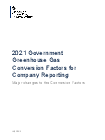Greenhouse gas reporting: conversion factors 2021
These emission conversion factors are for use by UK and international organisations to report on 2021 greenhouse gas emissions.
Documents
Details
Update January 2022
Due to a minor error in the version published in June 2021, we have updated the following factors (further detail in conversion factors spreadsheets and documents):
- Advanced and Condensed Set: Light rail factors on the ‘Business travel – land’ tab
- Advanced Set: Indirect/WTT Freight train factor on the ‘WTT- delivery vehicles and freight’ tab
- Advanced Set: Indirect/WTT Rail factors on the ‘WTT -pass vehicles & travel (land)’ tab
- Methodology Paper: Table 26 (tram and light rail)
We provide 3 sets of conversion factors:
- condensed set: this abridged version of the full set is easiest to navigate and most frequently requested. It’s recommended for most, and new, users of conversion factors
- full set: all the available factors for the selected year, recommended for advanced users only due to the volume of information
- flat file set: not recommended for most users, it contains the same information as the full set, but is arranged for automated processes. Flat files only available from 2014 onwards
We recommend that new users read the introductory guidance in the latest condensed set of conversion factors, then follow the text at the top of each conversion factor tab in the output files.
Repeat users should read the ‘what’s new’ sheet before using the conversion factors, which highlights the most significant changes made to the conversion factors for that update. This will ensure that reporting is consistent and comparable year-on-year.
The methodology paper explains how the conversion factors are derived. The major changes report summarises large changes in individual factors since the last edition. The statement of voluntary compliance with the Code of Practice for Statistics outlines how the conversion factors adhere to the pillars of trustworthiness, quality and value as set out in the Code.
Defra’s Environmental reporting guidelines provide more detail.
Last updated 24 January 2022 + show all updates
-
Due to a minor error in the version published in June 2021, we have updated the following factors (further detail in conversion factors spreadsheets and documents): Advanced & Condensed Set: Light rail factors on the ‘Business travel – land’ tab, Advanced Set: Indirect/WTT Freight train factor on the ‘WTT- delivery vehicles & freight’ tab, Advanced Set: Indirect/WTT Rail factors on the ‘WTT -pass vehicles & travel (land)’ tab, Methodology Paper: Table 26 (tram and light rail).
-
First published.


